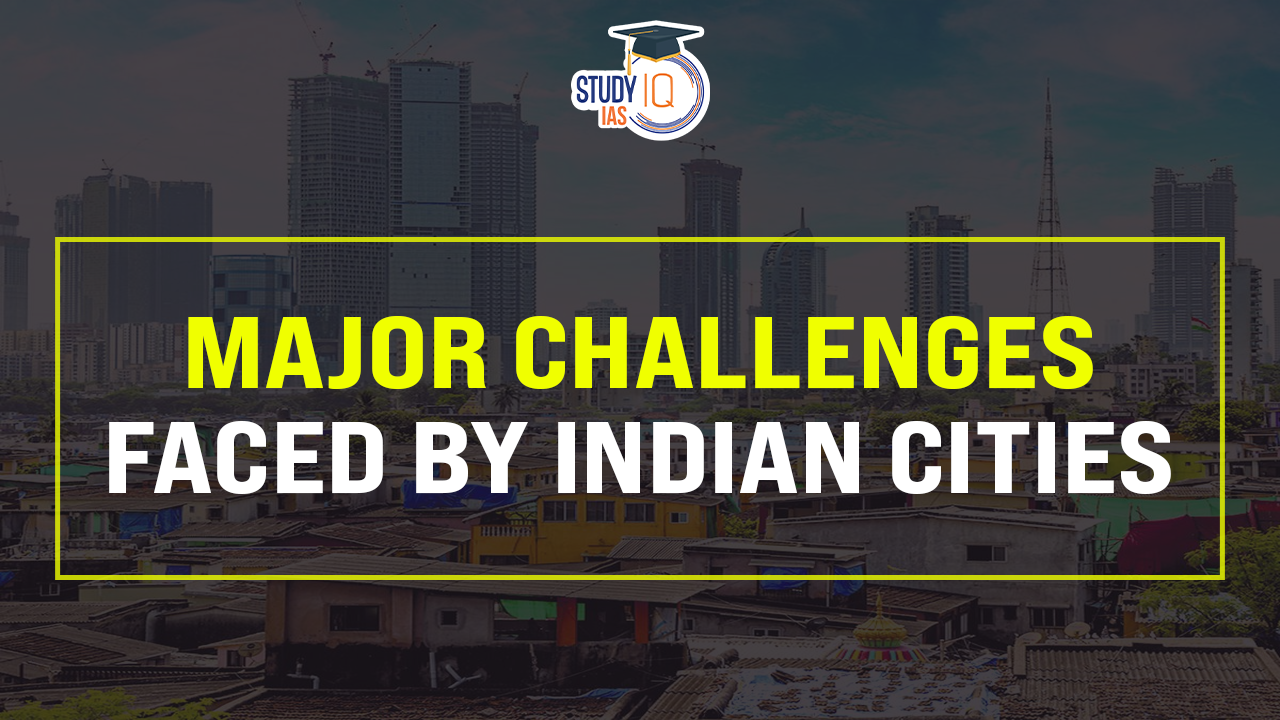Table of Contents
What are the challenges faced by Cities?
- The UN underscores that cities face unprecedented challenges, especially climate change. While strides have been made towards Sustainable Development Goals (SDGs), urban centres remain plagued by poverty, inequality, and environmental degradation.
- In the Global South, these challenges are intensified by rapid urbanisation, inadequate infrastructure, and limited resources.
- Cities here often suffer from housing shortages, poor access to clean water and sanitation, and increased vulnerability to climate-related events.
| Fact |
| The world’s urban population has reached an estimated 4.7 billion, or 57.5% of the world’s total population, with projections to double by 2050. |
What is Meant by Urbanisation?
- Urbanisation is the process by which an increasing proportion of a country’s population shifts from rural to urban areas, leading to the growth of cities and towns.
- This process involves the transformation of society, economy, and infrastructure as areas become more densely populated, industrialised, and developed.
- Urbanisation is driven by factors such as job opportunities, better living standards, and improved access to education, healthcare, and other services in urban centres.
- In sociology, the term is also used to describe the change in the way of life in the cities due to dense, heterogeneous populations in urban areas.
| Some Of The Terms Associated With Urbanisation |
Urban Agglomeration
Out Growths
Over Urbanisation
Suburbanisation
Counter Urbanisation
Urbanism It is the study of how inhabitants of urban areas such as towns and cities interact with the built environment. New Urbanism It is an urban design movement which promotes environmentally friendly habits by creating walkable neighbourhoods containing a wide range of housing and job types. |
Causes of Urbanisation
- Natural Population growth
- India’s population is constantly increasing due to which urban population is also increasing.
- Also, in urban areas, birth rates are usually higher than mortality rates due to availability of better medical and health facilities, sanitation and hygiene, good drinking water supply etc.
- Industrialisation
- Historically, formation of the urban areas was the direct result of the industrial revolution as people started to migrate to work in the industries. Industrialisation plays an important role in urbanisation even today.
- People from Uttar Pradesh and Bihar in some of the most industrialised states like Maharashtra and Haryana.
- Better facilities
- People usually migrate to cities for better social services such as improved education, healthcare, sanitation, higher living standards etc.
- Better employment opportunities
- An urban economy accounts for more service sector-oriented jobs like IT, Banking, Transport, Hospitality etc where people can be accommodated.
- It also includes both low-skilled as well as high-skilled jobs so that people with every type of skills can find employment.
- Also, Higher-value-added occupations are created and increased by services and industries, resulting in additional work possibilities
- More trade and commerce
- People in urban areas have higher purchasing power and more disposable income in their hands which helps in creating demand for the products and services.
- Cities provide better business possibilities and returns than rural regions.
- Cosmopolitan culture
- An urban community is more cosmopolitan in nature as people from different regions within the state and also from other states live in urban areas.
- It is a blend of people with diverse ethnic, linguistic and religious backgrounds
- It also offers anonymity of caste which sometimes plays an important role in migration of lower caste people from the rural areas.
- Expansion of city boundaries
- As cities get expanded, rural areas and semi-urban towns found on the outskirts also get included in urban areas.
- These areas gradually change their socio-economic characteristics similar to an urban area as they come in contact with the nearby city. As a result, the rural population is transformed into an urban population.
How does India’s urbanisation trajectory differ from the cities in the Global North?
- In Western countries, urbanisation followed industrialisation, which created jobs that absorbed rural labour.
- Their urbanisation was sustained also because of massive economic transfers from colonies.
- g., India alone contributed over $45 trillion to England’s economy during colonial rule.
- In contrast, India’s urbanisation is largely driven by economic distress, resulting in “poverty-driven urbanisation,” with both rural-to-urban and urban-to-urban migration.
- During the COVID-19 pandemic, the strain on urban planning became apparent, as reverse migration trends highlighted gaps in infrastructure.
Urban Challenges in India
- Lack of Reliable Data: Without the latest Census from 2021, India is left without clear data on how many people actually live in its urban areas.
- According to World Bank estimates, around 40% of India’s population may live in urban areas across nearly 9,000 towns and cities, but without updated data, it’s difficult to plan for their needs accurately.
- Outdated and Ineffective Urban Planning:
- Plans that Don’t Keep Up: Many urban planning strategies rely on old data and fail to anticipate rapid population growth.
- This results in cities stretched beyond capacity, with poorly designed layouts and traffic congestion that wasn’t part of the plan decades ago.
- The Impact of Lost Jobs: Since the 1980s, deindustrialisation has cost many their livelihoods, particularly in cities like Ahmedabad, Delhi, Surat, and Mumbai.
- Workers who lost jobs moved to peri-urban areas where living conditions are often crowded and lacking in basic services.
- Today, 40% of urban residents live in slums, facing daily struggles with inadequate housing and poor sanitation.
- Growth for Whom?: Much of urban planning tends to focus on capital growth—building upscale neighbourhoods, high-rise buildings, and business hubs.
- But these developments cater to a small, wealthy population, leaving millions without basic amenities or secure housing.
- Plans that Don’t Keep Up: Many urban planning strategies rely on old data and fail to anticipate rapid population growth.
Environmental and Climate Pressures:
- Cities Struggling to Breathe: Pollution is a major health hazard in urban India, with air quality deteriorating significantly in recent years.
- The National Capital Region (NCR) around Delhi, for instance, has eight out of the country’s ten most polluted cities.
- This means millions are breathing in toxic air every day, facing serious health risks.
- Vulnerable to Flooding and Extreme Heat: Indian cities are prone to extreme climate effects, from urban flooding during the monsoon season to “heat island” effects where concrete and buildings trap heat, making city temperatures soar.
- Both impact quality of life and add to public health issues, especially for vulnerable groups.
Governance Gaps
- Limited Local Control: Even though the 74th Constitutional Amendment aimed to empower local governments, urban areas are still largely run by undemocratic entities like parastatals or private bodies.
- Elected representatives often lack the real authority to make impactful decisions.
- Insufficient Funding and Resources: Less than three of the 18 municipal functions listed in the 12th Schedule have been fully transferred to local governments.
- Cities receive only 5% of GDP in intergovernmental funding, leaving them severely limited in addressing core issues like waste management, road maintenance, and healthcare services.
| Government Measures | |
For Better Governance
For Creating Employment Opportunities
For Better Transportation Facilities
For Affordable Housing
For Drinking water and sanitation
For Reducing Pollution
|
Why Do These Issues Matter?
- Without effective planning and adequate resources, urban life can be challenging and even unsafe. Millions live in overcrowded areas with limited access to clean air, green spaces, and healthcare.
- The lack of local control over urban planning means that critical decisions are made without considering residents’ everyday needs.
- Addressing these challenges is essential for building cities that don’t just grow but thrive, offering a better quality of life for all residents, not just a privileged few.


 Bharat Bandh 9 July 2025: Over 25 Crore ...
Bharat Bandh 9 July 2025: Over 25 Crore ...
 Elon Musk’s America Party: A New Chapt...
Elon Musk’s America Party: A New Chapt...
 Bihar Assembly Election 2025: Complete G...
Bihar Assembly Election 2025: Complete G...





















